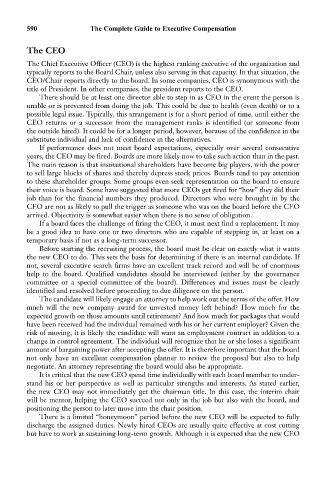Page 604 - Bruce Ellig - The Complete Guide to Executive Compensation (2007)
P. 604
590 The Complete Guide to Executive Compensation
The CEO
The Chief Executive Officer (CEO) is the highest ranking executive of the organization and
typically reports to the Board Chair, unless also serving in that capacity. In that situation, the
CEO/Chair reports directly to the board. In some companies, CEO is synonymous with the
title of President. In other companies, the president reports to the CEO.
There should be at least one director able to step in as CEO in the event the person is
unable or is prevented from doing the job. This could be due to health (even death) or to a
possible legal issue. Typically, this arrangement is for a short period of time, until either the
CEO returns or a successor from the management ranks is identified (or someone from
the outside hired). It could be for a longer period, however, because of the confidence in the
substitute individual and lack of confidence in the alternatives.
If performance does not meet board expectations, especially over several consecutive
years, the CEO may be fired. Boards are more likely now to take such action than in the past.
The main reason is that institutional shareholders have become big players, with the power
to sell large blocks of shares and thereby depress stock prices. Boards tend to pay attention
to these shareholder groups. Some groups even seek representation on the board to ensure
their voice is heard. Some have suggested that more CEOs get fired for “how” they did their
job than for the financial numbers they produced. Directors who were brought in by the
CEO are not as likely to pull the trigger as someone who was on the board before the CEO
arrived. Objectivity is somewhat easier when there is no sense of obligation.
If a board faces the challenge of firing the CEO, it must next find a replacement. It may
be a good idea to have one or two directors who are capable of stepping in, at least on a
temporary basis if not as a long-term successor.
Before starting the recruiting process, the board must be clear on exactly what it wants
the new CEO to do. This sets the basis for determining if there is an internal candidate. If
not, several executive search firms have an excellent track record and will be of enormous
help to the board. Qualified candidates should be interviewed (either by the governance
committee or a special committee of the board). Differences and issues must be clearly
identified and resolved before proceeding to due diligence on the person.
The candidate will likely engage an attorney to help work out the terms of the offer. How
much will the new company award for unvested money left behind? How much for the
expected growth on those amounts until retirement? And how much for packages that would
have been received had the individual remained with his or her current employer? Given the
risk of moving, it is likely the candidate will want an employment contract in addition to a
change in control agreement. The individual will recognize that he or she loses a significant
amount of bargaining power after accepting the offer. It is therefore important that the board
not only have an excellent compensation planner to review the proposal but also to help
negotiate. An attorney representing the board would also be appropriate.
It is critical that the new CEO spend time individually with each board member to under-
stand his or her perspective as well as particular strengths and interests. As stated earlier,
the new CEO may not immediately get the chairman title. In this case, the interim chair
will be mentor, helping the CEO succeed not only in the job but also with the board, and
positioning the person to later move into the chair position.
There is a limited “honeymoon” period before the new CEO will be expected to fully
discharge the assigned duties. Newly hired CEOs are usually quite effective at cost cutting
but have to work at sustaining long-term growth. Although it is expected that the new CEO

